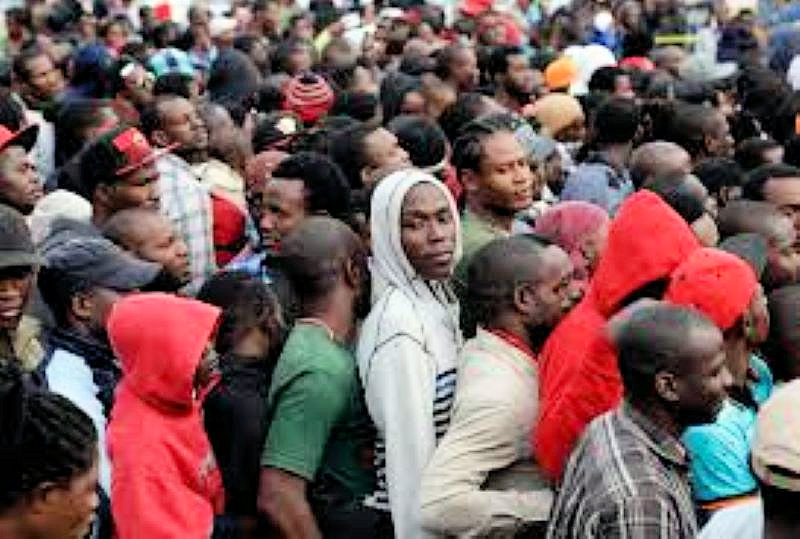On Feb. 9, Immigration and Customs Enforcement (ICE) sent yet another planeload of Haitians back to Haiti. The day before, 72 Haitians were deported, including 22 kids. Deportation analysts believe there will be additional Haiti flights on Feb. 11 and 12, two each day. Each ICE flight to Haiti is estimated to carry roughly 135 persons.
Last week, deportation flights to Haiti resumed as a Trump-appointed judge in Texas defied the Biden administration’s 100-day deportation moratorium. On Feb. 2, the same day Biden issued an executive order to “establish a task force to reunite families separated at the border under the Trump administration,” ICE sent a planeload of detainees to Haiti, seemingly in defiance.
But the mass deportations to Haiti by a Democratic administration in the past few weeks are nothing new. In fact, not coincidentally, they look very similar to Haitians’ stepped-up deportation in the last year of the Obama administration.

Those deportations in 2016 happened so covertly that they went largely unreported, even by Haitian-American media, by and large. After Haiti’s devastating 2010 earthquake, the U.S. had suspended deportations to the country. They were partly resumed a year later by sending back people convicted of “serious crimes.” Typically, they would deport about 50 people per month to Haiti.
However, in the final months of the Obama administration, there was an abrupt move subjecting any new Haitians entering the U.S. to “expedited removals.” On Sep. 22, 2016, Jeh Johnson, Secretary of Homeland Security, issued a directive to apprehend, detain, and deport Haitian nationals arriving in the U.S., starting the next day. As a result, deportations to Haiti increased 1,700% when, a few months later, the Trump administration began adding to the expulsion rolls the 30,000-plus Haitians who had orders of removal prior to the earthquake.
Haitian migrants had previously triggered U.S. immigration crackdowns. The practice of keeping immigrants detained indefinitely started with Haitian refugees in 1981. Previously, since 1954, undocumented immigrants were “paroled” into American society. Only people deemed a “risk,” either for health or public safety reasons, would be detained.
The indefinite detainment of Haitian immigrants, initiated under the Reagan administration, was, without a doubt, racially motivated. As often happens under capitalism, a blatantly racist policy reserved for the most reviled soon became common practice, applied to all. This was the genesis of what would become the “Immigration Detention Industry,” necessitating the construction of the massive immigration detention centers and networks of municipal jails.
Many in the general public, including the Haitian community, are shocked to learn that the bulk of today’s deportations to Haiti stem from migration to the U.S./Mexico border and includes families with children and infants.
After the 2010 earthquake, Brazil and Chile began taking in displaced Haitian migrants. Their populations surged to over 90,000 in Brazil and 150,000 migrated to Chile from 2016 to 2018. “Brazil needed the cheap labor to build stadiums, hotels, and other structures to receive people for the 2014 World Cup and then later the 2016 Summer Olympics,” said Ninaj Raoul of the Brooklyn-based Haitian Women for Haitian Refugees (HWHR). “They were taking advantage of the low wage labor, by welcoming the earthquake survivors into their country.”

Soon anti-Haitianism, political instability, and joblessness began sending many Haitian migrants north to the United States, where they hoped to either reconnect with relatives or start over. “Once the Olympics were over in 2016, there was political turmoil and an economic downturn in Brazil, which led to Haitians being no longer welcome,” Ninaj explained. “In fact they were being pushed out. Basically they were no longer needed there.”
Having made the perilous journey through jungles and regions hostile to Black people, tens of thousands of Haitians and African immigrants reached Tijuana, Mexico in hopes of entering the United States. “The canopy in the jungles was so thick,” said one Haitian migrant who made it to San Diego, CA with his pregnant wife, “that we didn’t see the sun for weeks.”
I met such migrants when I visited the Haitian Bridge Alliance in San Diego in 2017, interviewing survivors of the journey who described people getting killed by panthers in the Brazilian and Colombian jungles, pregnant women being denied medical help in Central America because of their race, hiding from police and armed men in Nicaragua, and receiving help from indigenous people who recognized that they posed no threat.
The migrants had to pass through nine or ten countries to get to Mexico. Ninaj Raoul of Haitian Women for Haitian Refugees (HWHR) received many of these migrants at her Flatbush office ” I met a man who survived getting shot in the head in Nicaragua,” she said. “I met women who were raped by local officials, soldiers, and coyotes [smugglers] who were supposed to be assisting them on the treacherous journey. Some were attacked by wild animals. If there was a family member that died, people had to press on, and there was no time for proper burials.”
Violence, sickness, injuries, starvation and dehydration were common causes of death on the journeys. “There was a young child, 14, whose leg was injured,” said one Haitian interviewee in a Haitian Bridge Alliance report. “It became infected and got worse. The mom had to stay behind until he passed away.”
In the same report, 29 of the 30 women interviewed stated they went 3-15 days without eating during the journey. For pregnant women, the trip was an even higher risk. “ I was scared the entire time that I would give birth in the bushes,” said one woman. “I went five days without eating while pregnant.”
Ninaj became aware of the transcontinental migration in February 2016 when some Haitian men began showing up at her office with ankle bracelets. “That was the first time I had seen Haitian people who just entered the country with these electronic monitor bracelets, going straight from ‘decarceration to E-carceration’… In fact, there were instances where some had two ankle bracelets, one assigned by ICE, the other by a private company [Libre by Nexus].” Those paroled with ankle bracelets would get check-ups twice a week. Often, the check-ups would consist of a phone call demanding that they go nowhere. The penalty for not being at a designated location could be redetainment or deportation.

According to Ninaj, bond companies that had access to the jails would sign up immigrants for the ankle bracelet program, in which they had to pay $420 a month. “They approach you in jail like they’re hooking you up and doing you a favor,” she explained. “And you believe it, because you want to get out. Sometimes they even give them a cell phone so they can keep track of them and pressure them to make the monthly payments.”
The San Diego Alliance, another immigrant rights group, began notifying Ninaj that an influx of Haitian migrants was heading her way. Soon, for Haitians who had crossed over the U.S./Mexico border, HWHR became the default assistance organization, not just for New York, but for the entire Northeast United States. Ninaj noted that most of the people had more formal education than previous groups with which she had worked. They left Haiti because of political persecution, lack of economic opportunity, or state-sponsored gang and gender-based violence. She pointed out that, since 1992 when the HWHR was founded, typically 50 Haitians a month would be deported from the U.S..
But on Sep. 23, 2016, as previously noted, the Obama/Biden administration began deporting 270 people a week. She believes the increase was for “political reasons,” to deprive then Republican presidential candidate Donald Trump of another immigration talking-point against Democratic candidate Hillary Clinton. Trump infamously branded Central Americans and Mexicans as “bad hombres” and rapists and in 2017 reportedly told aides that Haitians “all have AIDS.” Obama officials had hoped the uptick in deportations would stop the flow of migrants north, but it didn’t. In spite of the obstacles, more Haitian and African migrants continued to make the journey, regardless of the odds.
In addition to those arriving at the U.S./Mexico border, there are others who were detained and deported after living in the U.S. for many years. Among this group is Paul Pierrilus, 40, a long-time Spring Valley, NY resident who was born in St. Martin to Haitian parents. He is not a Haitian citizen and had never been to Haiti, having come to the U.S. at age five. He’d been making routine check-ins with ICE since 2006. On his Jan. 11 check-in, he was detained, then deported on Feb. 2.
Trump is not alone in creating today’s crisis surrounding the deportation of Haitians. Former Secretary of State Hillary Clinton contributed to Haiti’s current political instability and economic woe by facilitating President Michel Martelly’s election following the 2010 earthquake. Washington also abetted the controversial election of Martelly’s protégé, Jovenel Moïse, in 2016.
Since July 2018, the Haitian people have been trying to rid themselves of Jovenel Moïse, whom they see as Washington’s puppet. Last week, the Biden administration adopted the Trump administration’s policy of full support for Moïse, even endorsing his refusal to step down on Feb. 7, 2021 as the Haitian Constitution dictates. The U.S. thus creates more political turmoil, economic collapse, and human migration.

Haiti is today still caught in a vicious cycle which has repeated itself since the first U.S. military invasion of the country in 1915: Washington destabilizes the country politically and economically, installs and props up corrupt repressive puppets, then mass exodus ensues.
“These Haiti expulsions of virtually anyone who crosses the border seem to be very intentional Biden-team policy, not rogue ICE behavior, with the purpose of sending a deterrent message to Haitians in Mexico – ‘if you cross the border, you will be put on an airplane to Haiti” – in the period of weeks or months while the Biden team crafts new protocols for dealing with the border,” said Steve Forester, the Immigration Policy Coordinator for the Institute for Justice and Democracy in Haiti (IJDH). “Expelling an estimated 1,800 Haitians to Haiti – including hundreds of infants and children – during Black History Month and an extreme political crisis in Haiti remains inhumane and completely inappropriate. This should not be happening from an administration pledged to racial equity in every agency decision and permitting migrants access to asylum protections.”
“We at Haitian Women for Haitian Refugees are outraged by the discriminatory deportations that continue to be carried out by ICE in the midst of this global coronavirus/COVID-19 pandemic and while there is serious political crisis in Haiti, and a surge in kidnapping terrorism by government-backed gangs,” the HWHR said in a Feb. 9 statement. “In the same week that President Biden signed an executive order to launch a task force to reunite families separated by the Trump administration, this administration is deporting Haitians, including children and infants, in record numbers. This is a cruel contradiction that will further separate many families. It is simply careless and inhumane to deport individuals to Haiti, knowingly putting innocent people, who have migrated to survive, in harm’s way. These deportations are wrongheaded, and current plans to deport 1,800 more Haitians to Haiti in the next two weeks must be stopped now.”
Note: Anyone interested in helping Haitian migrants fight deportation, here are some frontline organizations:
NEW YORK:
Haitian Women for Haitian Refugees: (718)462-0791, Haitianwomen@AOL.com
CALIFORNIA:
Haitian Bridge Alliance: (949) 295.1253, Info@Haitianbridge.org
FLORIDA:
FANM: (305) 756-8050 info@fanm.org
MASSACHUSETTS:
Institute for Justice & Democracy In Haiti (IJDH): (857)-201-0991, info@ijdh.org











